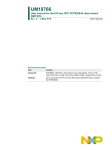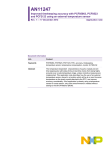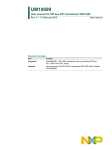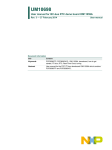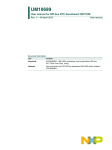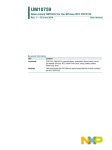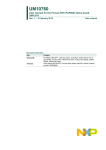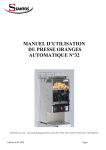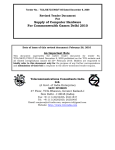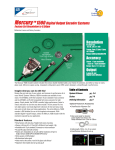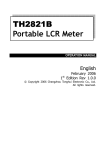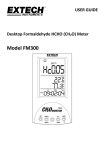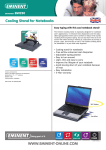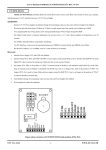Download PCF85063 User Manual: Objective
Transcript
NXP PowerPoint template Guidelines for presentations Name Subject Project Markus Hintermann DAY, MONTH, YEAR PCF85063 User Manual V1 Product Line CWG June. 2012 PCF85063 User Manual: Objective Key features Hardware set up Software set-up RTC tuning General COMPANY CONFIDENTIAL PCF85063 PL-CWG, M. Hintermann 2 June 18, 2012 Key feature PCF85063TP Real time clock with very small form factor, counting seconds, minutes, weekdays, weeks, month and years Electronic tuning Interrupt: every 30s or every minute Interface: 400kHz I2C-bus Package: HWSON8 package: 2.6 x 2.6 x 0.5 mm COMPANY CONFIDENTIAL PCF85063 PL-CWG, M. Hintermann 3 June 18, 2012 Hardware set-up The RTC circuit just requires one external part: a tuning fork quartz as resonator. The oscillation capacitors are integrated and therefore no need for external capacitors. The quartz crystal must be placed close to the RTC circuit, avoiding long lines which may pick up noise. Avoid any tracks with high frequency signals (fast edges) close to the RTC, quartz or quartz interconnect. The interface is the standard Fast Mode I2C-bus, operating up to 400kHz. Adjust pull-up values to match the required interface speed keeping them as high impedance as possible for power system saving. Ensure that the specified minimum requirements of the hold times tLOW & tHIGH are fulfilled. Supply voltage: The RTC is specified from 1.8 to 5.5V. The RTC, excluding the I2C-bus interface, is however operating down to a lower voltage. It is recommended to have a decoupling capacitor on the VDD-VSS rails close by. Due to the low power consumption of below 1 μW, no precautions for heat dissipations are required. CLKOUT can be used to measure the frequency COMPANY CONFIDENTIAL PCF85063 PL-CWG, M. Hintermann 4 June 18, 2012 Software set-up The RTC PCF85063 is controlled via standard I2C-bus interface. Common I2C protocol applies. The interface is the standard Fast Mode I2C-bus, operating up to 400kHz. Theoretically there is no low speed limit, however the access of the RTC should be performed within less than 1 second, otherwise second increments could be lost. During access the time registers of the RTC are frozen and after the read or write sequence is completed a seconds increment is executed if required. The clock tracks the actual time from seconds to year. It must be initially set to the correct time of the actual time zone. The days per month and leap year are corrected automatically. Leap years are assumed whenever the year is divisible by 4. The RTC can be programmed to generate an interrupt every 30 second or every 60 seconds. Byte number 03 is a general purpose RAM byte to store temporary information. System testing there is a fast mode facility to test the functionality of the RTC, it can be activated by setting the EXT_TEST bit in the Control_1 word. The RTC 85063 has a frequency tuning facility, its operation is explained in the specific chapter. The RTC can stay switched on all the time. There is no need to restart or reset the clock. COMPANY CONFIDENTIAL PCF85063 PL-CWG, M. Hintermann 5 June 18, 2012 Software set-up . Setting the clock to 3.45 pm December 15, 2011, Thursday I2C-bus Start condition Slave address 1010 0001 write bit set Register address 0000 0000 address pointer to status word 0 Status word 0 0000 0011 set 12h mode and select option for 12.5pF quartz I2C-bus repeated start condition Slave address 1010 0001 write bit set Register address 0000 0100 printer to seconds register Seconds 0000 0000 0 Seconds (clock integrity ok MSB OS=0) Minutes 0100 0101 45 min Hours 0100 0011 PM, 3 (clock integrity ok OS=0) Days 0001 0101 15thn Weekdays 0000 0100 Thursday (4th day of the week) Month 0001 0002 December Year 0001 0001 (20)11 I2C-bus Stop condition COMPANY CONFIDENTIAL PCF85063 PL-CWG, M. Hintermann 6 June 18, 2012 Software set-up .. Reading the clock (~2 minutes later than the writing) I2C-bus Start condition Slave address 1010 0001 Register address 0000 00100 address pointer to seconds byte (4) I2C-bus repeated start condition Slave address 1010 0000 read mode Read register 4, seconds .... .... e.g 56 Seconds, (clock integitiy ok OS=0) Minutes .... .... e.g 46 Minutes Hours .... .... e.g. 23 PM 03h Days .... .... e.g. 15 15. Weekdays .... .... e.g. 04 Thursday Month .... .... e.g. 12 December Year .... .... e.g. 11 (20)11 I2C-bus Stop condition write bit set COMPANY CONFIDENTIAL PCF85063 PL-CWG, M. Hintermann 7 June 18, 2012 Frequency tuning The 32kHz quartzes are typically sold with a tolerance of either ±20 ±10 ppm at room temperature. 11.5ppm corresponds to 1s/day. The quartzes feature a characteristic load capacity of either 7pF or 12.5pf. Oscillators utilizing 7 pF quartzes feature a slightly lower power consumption, where the quartzes of 12.5 pF have largest production quantities. The tacks between quartz and RTC represent also some parasitic capacities and must be kept short. The PCF85063 has a tuning facility where above tolerances can be compensated. Tuning procedure: Measure the 32xxx Hz (f) signal at the CLKOUT pin. The offset is calculated in ppm as Δf[ppm]=106* (f-32768)/32768 Consult the offset table in the data sheet. Take the correction value and write it into the register 02h. The correction is done by means of inhibition or addition: the oscillator runs at constant speed, then every 2 hours (mode 0), 1 second is corrected to by making it shorter or longer, it is not easily visible at the CLKOUT. Corrections can also be applied every 4 minutes by using mode 1. This mode will consume more power. The 32 kHz quartzes are of the type tuning fork and feature a parabolic frequency response over temperature. When typical use is over a limited temperature range, it is often helpful to tune the frequency to be slight higher at the turn-over point. This is then compensated when the temperature is at either side of this. e.g. For operation between 4°C…45°C, tune the clock 8ppm faster than would be the value for 25°C. COMPANY CONFIDENTIAL PCF85063 PL-CWG, M. Hintermann 8 June 18, 2012











